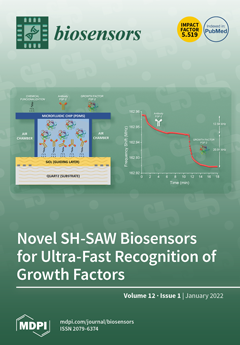Open AccessArticle
AuNP Aptasensor for Hodgkin Lymphoma Monitoring
by
Maria Slyusarenko, Sergey Shalaev, Alina Valitova, Lidia Zabegina, Nadezhda Nikiforova, Inga Nazarova, Polina Rudakovskaya, Maxim Vorobiev, Alexey Lezov, Larisa Filatova, Natalia Yevlampieva, Dmitry Gorin, Pavel Krzhivitsky and Anastasia Malek
Cited by 19 | Viewed by 4181
Abstract
A liquid biopsy based on circulating small extracellular vesicles (SEVs) has not yet been used in routine clinical practice due to the lack of reliable analytic technologies. Recent studies have demonstrated the great diagnostic potential of nanozyme-based systems for the detection of SEV
[...] Read more.
A liquid biopsy based on circulating small extracellular vesicles (SEVs) has not yet been used in routine clinical practice due to the lack of reliable analytic technologies. Recent studies have demonstrated the great diagnostic potential of nanozyme-based systems for the detection of SEV markers. Here, we hypothesize that CD30-positive Hodgkin and Reed–Sternberg (HRS) cells secrete CD30 + SEVs; therefore, the relative amount of circulating CD30 + SEVs might reflect classical forms of Hodgkin lymphoma (cHL) activity and can be measured by using a nanozyme-based technique. A AuNP aptasensor analytics system was created using aurum nanoparticles (AuNPs) with peroxidase activity. Sensing was mediated by competing properties of DNA aptamers to attach onto surface of AuNPs inhibiting their enzymatic activity and to bind specific markers on SEVs surface. An enzymatic activity of AuNPs was evaluated through the color reaction. The study included characterization of the components of the analytic system and its functionality using transmission and scanning electron microscopy, nanoparticle tracking analysis (NTA), dynamic light scattering (DLS), and spectrophotometry. AuNP aptasensor analytics were optimized to quantify plasma CD30 + SEVs. The developed method allowed us to differentiate healthy donors and cHL patients. The results of the CD30 + SEV quantification in the plasma of cHL patients were compared with the results of disease activity assessment by positron emission tomography/computed tomography (PET-CT) scanning, revealing a strong positive correlation. Moreover, two cycles of chemotherapy resulted in a statistically significant decrease in CD30 + SEVs in the plasma of cHL patients. The proposed AuNP aptasensor system presents a promising new approach for monitoring cHL patients and can be modified for the diagnostic testing of other diseases.
Full article
►▼
Show Figures






